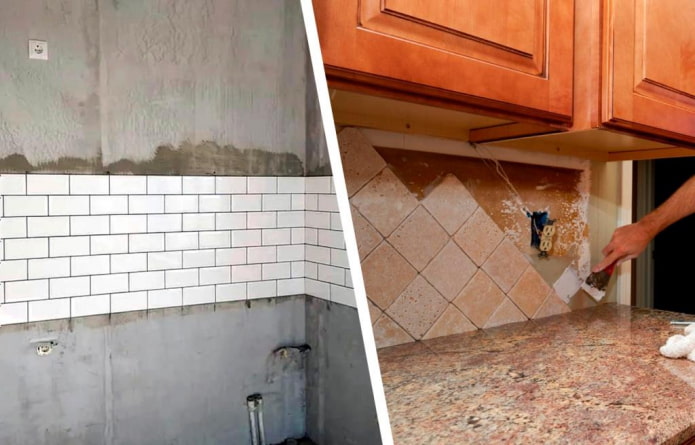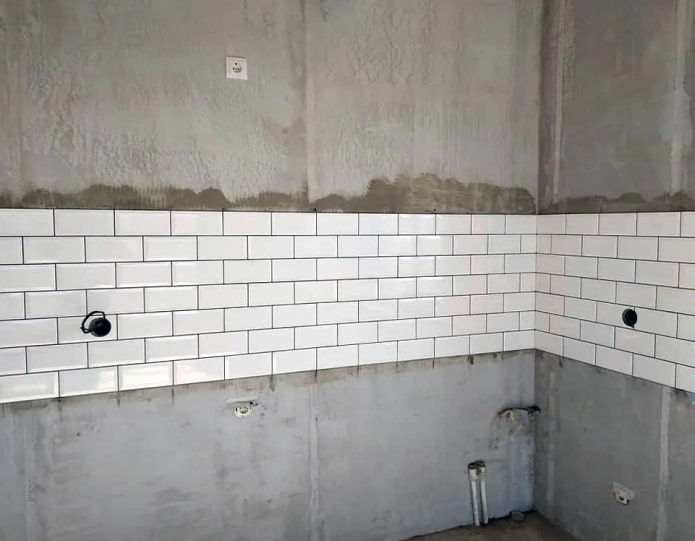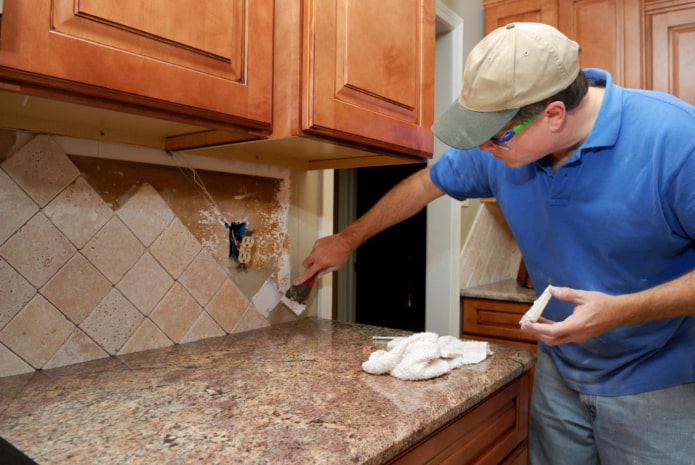Apron first
This option seems to be easier to implement, especially if you not demanding on aesthetics kitchen. First, with a margin is put ceramic tile, then the lower cabinets are placed, and then the upper cabinets are hung.
Pros:
- The main advantage of the method in that less time will be spent on repairs. The installation will finish faster, and you will save yourself from unnecessary cleaning - the headset will fit into a fully finished kitchen and you will not have to wash it from tile glue.
- A significant plus - saving money. Careful adjustment of the backsplash to the size of furniture and tiles requires high qualifications of the designer of the kitchen set and workers. In the case when the tiles are laid on their own, and the furniture is assembled by hand, it is more convenient and cheaper to first revet the cooking area.
Minuses this option also has:
- Furniture will not adjoin the wall, it will stand close to the tile. This threatens with gaps where dirt and water will enter, especially if the walls or floor are not perfectly aligned.
- The gap will have to be closed with a corner or side, which rarely looks attractive.
- The tile is stacked with a margin, which means you will need to purchase more material.
- There is a risk of overlapping the pattern on the apron, and also not to get into the seam and "cut" the one-piece element in half. The problem is partially solved by adjusting the height of the furniture using the legs.
If a glass apron, this sequence is unacceptable: its installation is carried out only after the complete installation of kitchen furniture and built-in appliances.
Headset first
In this case, the first thing to do is to install the furniture, and then put the apron. Professionals prefer this method because it is easier to fit an apron under the kitchen than vice versa.
Pros:
- The kitchen looks like one, looks more elegant and expensive.
- The pattern on the tile is not cropped, and the lower and upper modules of the headset are closely adjacent to the apron.
- The curbstones can be slid against the wall and do without a sealing skirting board between the worktop and the apron: gaps simply will not appear.
Minuses:
- The job takes more time.
- Laying the apron requires professionalism workers, which is difficult to predict.
- Installation of tiles will have to be carried out as carefully as possible: Protect facades from chips and dents, and countertops from dirt. Any damage to the tile itself will be more noticeable, so you should cut it carefully.
- Apron cladding gets complicated because of the lower pedestals standing "in the way".
conclusions
If you want to save, and aesthetics is not in the first place for you, first lay the tiles, and then install the headset. In this case, adjusting the elements to each other is difficult, but doable - competent measurements work wonders.
If you want the perfect kitchen, place the furniture first and then install the tiles. Also, the method is effective if there are irregularities on the walls: using tile glue, the plane can be trimmed.
Both methods have the right to life - choose the one that suits you best.


 10 practical tips for arranging a small kitchen in the country
10 practical tips for arranging a small kitchen in the country
 12 simple ideas for a small garden that will make it visually spacious
12 simple ideas for a small garden that will make it visually spacious




 How to choose the color of your kitchen sink?
How to choose the color of your kitchen sink? White kitchen set: features of choice, combination, 70 photos in the interior
White kitchen set: features of choice, combination, 70 photos in the interior Black set in the interior in the kitchen: design, choice of wallpaper, 90 photos
Black set in the interior in the kitchen: design, choice of wallpaper, 90 photos How to choose curtains for the kitchen and not regret it? - we understand all the nuances
How to choose curtains for the kitchen and not regret it? - we understand all the nuances Design of a white kitchen with a black countertop: 80 best ideas, photos in the interior
Design of a white kitchen with a black countertop: 80 best ideas, photos in the interior Kitchen design with green wallpaper: 55 modern photos in the interior
Kitchen design with green wallpaper: 55 modern photos in the interior